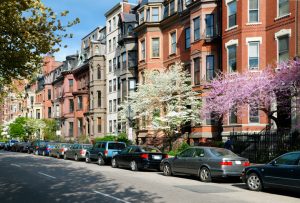By David Feehan
 The media are full of stories of cities removing on-street parking spaces to create bike lanes. Let me state at the outset that I am all in favor of bike-riding, though I don’t count myself among bike riders. I am also aware of and support efforts to reduce greenhouse gases and bikes have numerous advantages in terms of the nation’s and the world’s health and well-being.
The media are full of stories of cities removing on-street parking spaces to create bike lanes. Let me state at the outset that I am all in favor of bike-riding, though I don’t count myself among bike riders. I am also aware of and support efforts to reduce greenhouse gases and bikes have numerous advantages in terms of the nation’s and the world’s health and well-being.
I am still waiting to see, however, the definitive study measuring the effect of eliminating on-street parking in business districts on merchants and their survival.
A few years ago, I was part of a team conducting a parking study in Fort Collins, Colo. The question came up: What would be the effect of eliminating on-street parking on one of that city’s busy downtown streets?
We were not commissioned to answer that question. But as the former director of downtown organizations in Kalamazoo; Detroit; Columbia, Md.; and Des Moines, along with business district organizations in Pittsburgh, I had some understanding of what convenient parking meant to local merchants. So I did some rough calculations.
I estimated the typical block in downtown as being 300 feet in length, then subtracted 10 feet on each end to gauge the frontal linear feet of storefronts. That equaled 280 feet. I estimated that most storefronts were 20 feet in width. I figured each parking space should be 18 feet long, so this meant about 15 parking spaces per block. I estimated the stores would be about 100 feet deep. That means the block would have about 28,000 square feet of selling space, and I was told that most merchants were averaging sales of $150 per square foot, though some were doing as well as $400 a square foot. This meant that the block should be doing at least $4.2 million in sales annually. A rough estimate would suggest that each parking space on that block was worth $280,000 in sales to that block, or $20,000 in sales to each merchant. As you can see, removing parking in front of the store could have a major effect on downtown businesses.
Of course, these are rough calculations. They do not account for nearby surface lots or parking garages, nor do they account for patrons riding bikes or on foot. But many cold-weather cities see bike and walking traffic decline precipitously when it’s snowing or sleeting, and many depend on the nighttime economy to survive–and many people feel safer having a car at night. For those of us in the downtown management business, it is a powerful argument for having the merchant and his or her employees park in a location other than in front of the store.
So before a city decides to eliminate on-street parking, someone should do a careful and rigorous analysis of the impact on Main Street. A lively Main Street can make the difference in attracting people to your town; a vacant, lifeless Main Street can have the opposite effect. Just ask your local merchant.
David Feehan is president of Civitas Consultants, LLC.




















